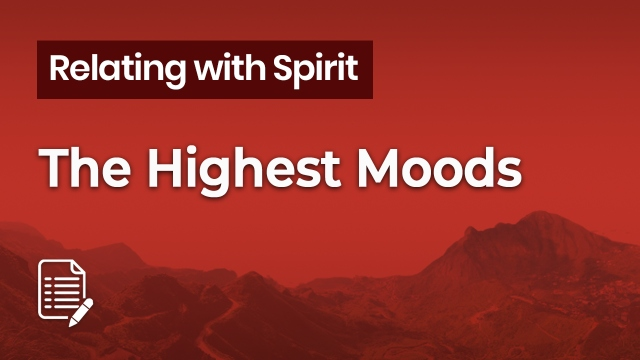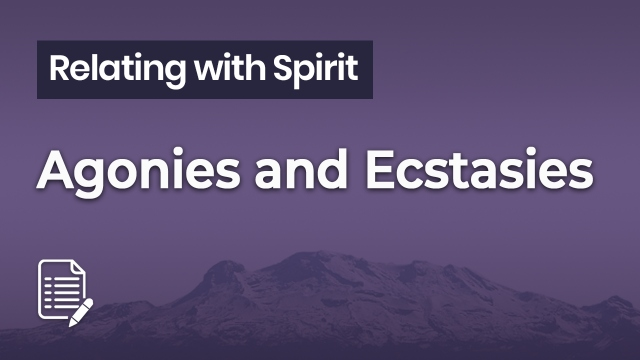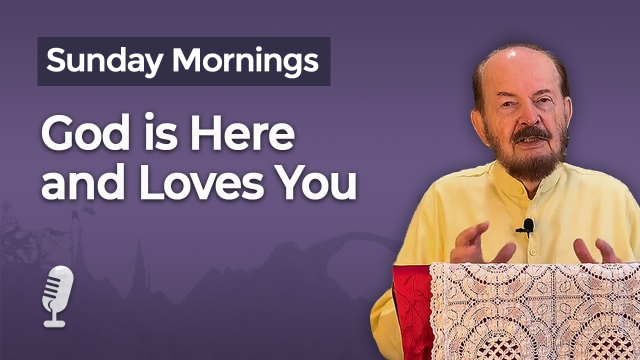
Ramakrishna Ananda
Friends of God and the Incarnation
Find out how to have a transforming relationship with God
Millions of religious people think of God as their friend. They often like to think of the higher consciousness as having subtle form, of being embodied. For example, many Christians feel that Jesus Christ, in subtle form, an embodiment of higher consciousness, is their friend. They feel His presence.
They can, when in a superconscious state themselves, perceive his subtle form. They walk with him and talk with him, as the hymn says. They feel Jesus to be their real, embraceable Lord and friend. They feel he is beside them at their work or especially when they are in difficulty.
When they pray they sense they are not speaking to a distant, possibly diffused body of light and power, but that Jesus is there sitting before them or kneeling beside them in their room. They are certain they are not engaged in imagination although, they grant, many people may engage in imagination.
Friends of Christ Find Proof
Friends of Christ find proof they are actually experiencing the higher consciousness because of the improved quality of their lives and the transformation of their previously uncooperative character. They see, in the physical, material, and daily events of their lives, definite manifestations of the presence of their friend. They credit their friend for the greater opportunities which come their way. They recognize the handiwork of their friend in the increased security and peace in which they live. Very often they find help or inspiration bounding on the miraculous. These grateful friends observe their Lord entering into the relationships they have with other people and creating a pronouncedly different or improved state in those relationships. When in danger, companions of Christ often find the hand of their friend protecting all concerned.
Other Christians who prefer to live in a friend to friend mood do not think of Jesus being in superphysical form but rather formless — a formless friend, pure spirit or light. They find that Christ acts as their friend without having any “human characteristics,” or dimensions, and are perfectly happy with this sublime relationship; however, it is difficult, due to our human frailties and needs, to maintain this ethereal relationship. It’s much easier to forget the relationship completely at times if one is not predisposed to thinking of the Lord of one’s heart in form, in a person to person manner.
Ishta — Eastern Religious Term
Eastern religions have a word for this aspect of higher consciousness and spirituality. One who thinks of the Lord in form is worshipping and relating to what is called an ishta. This phenomenon of the ishta is extremely helpful to those entering into the friend to friend relationship and all subsequent moods of higher consciousness. The ishta concept can certainly be of help, too, in the previous mood of the servant relationship.
However, in considering the ishta, the human form of God, communication between people becomes difficult. Millions of people strongly assert there is no God at all: not in any form nor absolute state, either. Sincere members of some faiths are certain God exists but has no human form. They look upon worshippers of an anthropomorphic God with pity, or sometimes hostility. Devout adherents of some other faiths are convinced that God has one divine/human form — and one form only. And then large numbers of Hindus worship numerous gods with divine and human attributes — who comprise different aspects of the one infinite source of all: Brahman.
A History of Religious Condemnation
It’s not easy to discuss God in form because people of some faiths condemn the religious, or spiritual, practices of those in other faiths. At times, including the present, lovers of God have been murdered for thinking of their Lord in a different way from what others insisted was the only way. Men and women who considered themselves dedicated and honorable people have imprisoned those outside their own religion. Also, as this spirit of self-righteous interpretation and opinion grows cruel from time to time, many people within most faiths have killed others who practiced the same religion differently. Witness the disappearance of the early leader of the Baptist Church in England who was very likely beheaded for questioning the divine right of kings, and for his views on baptism. Witness the mountains of bodies during the Thirty Year’s War in Europe (1618-1648) when religious differences divided a whole population.
Any reference to history will help people realize how far we must yet travel to give true love and good will to one another — not only as individuals but as groups too, as nations and faiths. Love and understanding are especially needed when the world’s religions are moved to share the Lord with others.
God as Man
Religious people who seek a mood of relationship with God almost always choose an Incarnation as their ishta — the form of God on whom they focus their minds and hearts. The concept of the Incarnation was initially an ancient Eastern idea (or realization) which moved West. You can trace the various Incarnations in different spaces of time and in different cultures by studying history and comparative religions. You can also observe the tremendous impact of the Incarnations on the overall well being of the civilizations which they served.
Devoted worshippers throughout the world are convinced God himself incarnated as man and is worthy of worship. Many people have been persecuted throughout the ages for believing in this tradition and seeking a personal relationship with the Incarnation of God — who is also called avatar, a descent of the Divine. Devotees who have a mood of relationship with an Incarnation, “God as man,” ask doubters: if God is real and omnipotent and can create the whole universe including mankind, why can’t he himself incarnate and walk the earth if he chooses?
It’s extremely fascinating for a student of religion to find there is a tradition of the God-man, the Incarnation, in many civilizations throughout history. The incarnation tradition is further complicated and confused, however, because some ancient societies also called their kings divine incarnations.
What are the Identifying Characteristics of an Incarnation?
Specific characteristics mark those great beings who were hailed and loved as Incarnations. An Incarnation:
- Is preceded by messengers who declare His coming.
- Is born of immaculate conception.
- Lives among the lowly.
- Demonstrates God’s grace alone is sufficient.
- Sacrifices His life out of love and as a propitiation for humanity.
- Clarifies the scriptures so that people can understand and practice them rightly.
- Adds something new which is particularly applicable to the era which He has come to serve and which will be of benefit to all future people.
- Cleans away the confusions in religious or spiritual practice caused by ignorant or incorrectly opinionated priestcraft.
Incarnations of God
Such Incarnations are Rama, Krishna, Zoroaster, Buddha, Jesus Christ, Chaitanya, and Ramakrishna. There may have been other Incarnations as well. These, however, are the main Incarnations recognized by millions and millions in the world today. (It’s important to note that most Buddhists do not consider Buddha an Incarnation, but Hindus and mystics generally think Gautama the Buddha had the characteristics of an Incarnation.)
Remember, some faiths do not recognize any Incarnations; and some people who recognize one Incarnation do not recognize any other Incarnation.
Ways of Loving the Lord
Commonly, those people who practice relating to higher consciousness through the different moods are dominantly devotional or religious. They find it easy and very natural to think of the Lord of their heart, the source of life, love, and existence, as an Incarnation. Millions of people around the world today choose to relate to God, the emanator of higher consciousness, through their chosen Incarnation. Their ways of loving their Lord and thinking of God are often extremely beautiful and charming.
Some devotees chant the name of their Lord and friend while looking at a picture or sculpture which represents the Incarnation. These devotees lovingly chant his name or utter praises of love to him. Others think of the Passion of Christ and worship him, recalling his death on a cross, and lovingly wear crucifixes and say the rosary. Hundreds of millions receive the body and blood of Christ into their beings through communion, regularly.
Other devotees in their relationship with the Divine offer little plates of food before the Lord at an altar placed in a room in their homes, feeling that the Lord — in spirit and in form — partakes of the food and blesses it before they themselves sit down to eat. Meantime, some other devoutly religious people would call these practices idolatry and would not be caught dead daring to think for a moment of the Lord having form or being able to express so personally. And such differences of view and doctrine have often caused warfare, perhaps from the beginning of man.
Also, it’s important to mention that millions of religious devotees think of the Lord as feminine, as well as masculine. They, by the millions, call upon the Lord as “Divine Mother.” They feel that the Lord is unconditionally loving, as is often the case with mothers in this world. They equate the Divine Mother with the Christian concept of the Holy Spirit. They feel the Divine Mother is an ever-available comforter who will never reject her child, whether that child be good or bad. Similarly, Roman Catholics — in their relationship with God — often pray to Mother Mary and numerous saints. Mary Baker Eddy, too, the founder of Christian Science, often referred to the feminine aspect of God when she spoke of “Father, Mother God.”
Friend to Friend
To clarify and sum up, the awe and servant relationships may — if you are so predisposed and able — mature into a new attitude, a new mood of the heart. Then you feel a soul-deep response to the call of higher consciousness which leads you to discover your true nature and value in the “eyes” of higher consciousness. A new and transformed person, you easily become a friend to higher consciousness. The two of you relate more intimately, friend to friend. You share life at a deeper level. While mindful of the greatness and amazing superiority of your senior companion, you feel free and welcome to chat and converse in rich dialogues with the higher consciousness — usually communicated superconsciously, non-verbally. In this friend mood of higher consciousness, you discover a greater capacity for intimacy and a person to Person relationship with the Lord.
Your relationship, being a true friendship, conducted at a higher level of awareness (not imagination), bears fruit in daily life. If you are not becoming a better person or a more able and competent person in your friend mood, chances are fantasy is dominating you. If your compassion for others is increasing and if your body and mind feel extremely blessed, then very likely you are experiencing the mood of relationship called friend to friend.
Playfulness Occurs
Remember, in this true friendship between the finite and the infinite, between two forms of higher consciousness (because now, you, a newly-awakened human being, have become a freely-expressive form of higher consciousness too), the marvelous aspect of playfulness occurs. Just as friends who love one another joke, tease, and inspire one another; just as they love to give presents and be of assistance to one another; just as they deeply enjoy being thoughtful of the other person and love the friend for this kindness; so too the higher consciousness and the devotee enter into much fun together!
Sometimes it may seem that your newfound friend is playing tag with you — running away and hard to find. At other times, in your career, for example, during particularly intense times, suddenly your special companion comes rushing into the room, filling it with light and a heavenly quality. Sometimes you suddenly feel touched and uplifted. Or, your heart unexpectedly expands with joy, realizing the unique friendship you are now having.
Give and Take
Ask any Catholic nun — that is, almost any nun — about her relationship with the Lord. If she is willing to share, she will charm you for hours describing “her” beloved Jesus. She may also, perhaps, confide her concern for many priests who seem to relate to God in an abstract manner and who talk about the Holy Spirit as if he’s not a person. Jesus is friend, husband, and Lord to many nuns.
For some people, the natural outgrowth of their quest for higher consciousness is a sense of a personal friend to friend relationship. For others, it’s just not conceivable and other possibilities seem more appropriate.
In the friend to friend relationship, both friends are important. The give-and-take is extremely valuable to the friendship. Although the higher consciousness is so much more aware, able, and infinitely more beautiful — at least it seems so to the new friend — both must contribute. Both must also be themselves. Both friends are essential to the relationship. Friendship cannot be one way.
Completely Satisfying
You are extremely fortunate to move forward from a servant relationship into the embrace of friendship. You find a new way of perceiving the world, as well as realizing a new value for yourself. The awe and servant relationships, however, are still precious to you because they keep you from ever taking the higher consciousness for granted and they prevent you from taking unfair advantage of the new relationship. Humility and the readiness to serve must be constituents in your makeup in order for the friendship to go on.
But what a possibility! A completely satisfying, perfect, and undying friendship.
Reflection
To think that all I ever need do
Is respond to You and your Love —
And that I shall never be lonely again!




